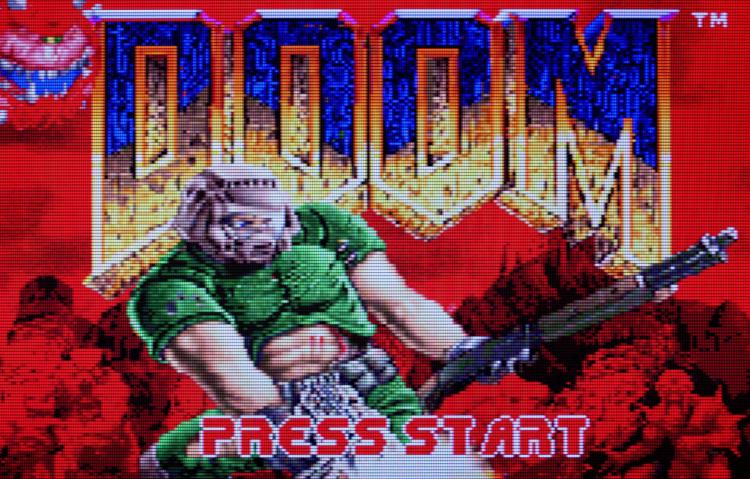DOOM: Dark Ages Inspiration - How Classic DOOM Influences Modern Development

Table of Contents
Groundbreaking Technology and its Modern Counterparts
ID Tech 1 and its Influence
ID Tech 1, the engine powering the original DOOM, was revolutionary for its time. Its influence on modern game engines is undeniable. Key innovations included:
- 3D Rendering: DOOM's use of 3D graphics, albeit relatively simple by today's standards, was a massive leap forward. This paved the way for the sophisticated 3D rendering techniques used in modern engines like Unreal Engine 5 and Unity.
- Fast-Paced Action: The engine was optimized for speed, allowing for fluid, fast-paced gameplay that remains a hallmark of the FPS genre. Modern engines strive for similar performance optimization to achieve smooth frame rates in increasingly complex game worlds.
- Binary Space Partitioning (BSP): DOOM's use of BSP for level design was groundbreaking. This technique efficiently divided complex 3D spaces into simpler shapes, allowing for faster rendering and easier level creation. Modern games still utilize advanced versions of BSP and other spatial partitioning algorithms for efficient level streaming and rendering, especially in large open worlds.
The performance optimization strategies employed in DOOM, such as clever level design and efficient use of textures, continue to be relevant in modern AAA titles. Developers consistently seek ways to balance visual fidelity with performance, a lesson learned from the resource-constrained environment of early 3D games.
Weapon Variety and Impactful Combat
DOOM's arsenal of distinct weapons, each with unique characteristics and satisfying feedback, set a standard for FPS weapon design. The iconic shotgun, for instance, remains a staple in many shooters due to its powerful close-range capabilities.
- Unique Weapon Characteristics: Each weapon in DOOM felt different, requiring varied strategies and tactics. This philosophy is evident in modern shooters, where weapon diversity is a key component of engaging gameplay.
- Satisfying Feedback: The sound design and visual effects of DOOM's weapons contributed significantly to the visceral and satisfying experience. Modern games strive for similar levels of impactful feedback to reinforce the player's actions and increase immersion.
Comparing the feedback mechanisms of DOOM's weapons – the satisfying chunk of the shotgun blast, the searing whizz of the plasma rifle – with the sophisticated effects of modern shooters reveals a clear lineage. The core principles remain the same: clear visual and auditory cues to enhance the player's sense of power and agency.
Level Design and the Importance of Exploration
Non-linear Level Design and Player Agency
DOOM's levels weren't just corridors; they were intricate mazes filled with secrets, hidden areas, and multiple routes to navigate. This non-linear approach emphasized player agency and exploration, a significant influence on modern game design.
- Exploration and Hidden Areas: The thrill of discovering hidden items and secret passages in DOOM continues to inspire the design of modern games, from open-world adventures to Metroidvania titles.
- Multiple Routes and Player Choice: DOOM's levels offered players choices in how they tackled each encounter, encouraging experimentation and strategic thinking. This philosophy is reflected in many contemporary games that prioritize player choice and freedom.
The impact of DOOM's level design is also evident in the thriving modern FPS map-making community. Many dedicated players continue to create levels inspired by the original game’s design principles, showcasing its enduring influence.
Environmental Storytelling and Atmosphere
DOOM's narrative was sparse, relying heavily on environmental storytelling and atmosphere to convey its chilling atmosphere. The game's effective use of lighting, sound effects, and level geometry created a sense of dread and isolation that modern games strive to replicate.
- Atmosphere through Environmental Design: The use of lighting, shadows, and sound in DOOM effectively set the mood, creating a sense of tension and suspense without relying on extensive cutscenes.
- Conveying Narrative through Environment: The limited narrative was effectively communicated through environmental elements: the decaying architecture, scattered remains, and unsettling soundscapes all contributed to the game's chilling atmosphere.
Modern FPS titles often employ similar techniques, showing how DOOM's minimalist approach to storytelling paved the way for more nuanced and immersive environmental narrative design.
The Legacy of Speed and Brutality
Fast-Paced Action and its Modern Iteration
DOOM's fast-paced, brutal gameplay, emphasizing speed and aggressive combat, has had a profound impact on the modern FPS genre. Games like DOOM (2016), DOOM Eternal, and Quake are direct descendants of this design philosophy.
- Aggressive Combat and Movement: DOOM's emphasis on aggressive combat and fluid movement is a defining characteristic of modern arena shooters and fast-paced FPS titles.
- Influence on Arena Shooters: The influence of DOOM's arena-style combat, focusing on skill and fast reflexes, is still felt strongly in the modern “arena shooter” subgenre.
Comparing the movement mechanics of classic DOOM with those of modern fast-paced shooters highlights the advancements in technology and design but also reveals a core similarity: the emphasis on speed, precision, and aggressive play.
The Enduring Appeal of Simple, Effective Gameplay
A key reason for DOOM's lasting influence is the simplicity and effectiveness of its core gameplay loop. The game's core mechanics—run, shoot, and survive—are deceptively simple yet deeply satisfying. Modern games often attempt to recapture this visceral and satisfying gameplay.
- Minimalist Design Philosophy: DOOM's minimalist design philosophy, prioritizing core gameplay over extraneous features, has inspired many modern developers to focus on delivering a streamlined and engaging experience.
- Capturing the Visceral Experience: Modern games often attempt to recapture the visceral and deeply satisfying feeling of DOOM's gameplay, showcasing the lasting appeal of its core mechanics.
The enduring appeal of DOOM's simple yet effective gameplay is a testament to its enduring impact on game design.
Conclusion
Classic DOOM, despite its age, remains a pivotal title in the history of video games. Its innovations in technology, level design, and gameplay continue to influence modern FPS development, shaping the experiences we enjoy today. From revolutionary engine technology to the enduring appeal of fast-paced, brutal combat, the dark ages of gaming gave us a title that continues to inspire. Explore the legacy of DOOM further. Dive into the history of FPS games and discover how this classic continues to shape the genre, influencing even the latest DOOM installments and beyond. Experience the enduring influence of DOOM for yourself!

Featured Posts
-
 Record High Temperatures La And Orange Counties Face Extreme Heat Emergency
May 13, 2025
Record High Temperatures La And Orange Counties Face Extreme Heat Emergency
May 13, 2025 -
 The Kyle Tucker Chicago Cubs Fan Backlash
May 13, 2025
The Kyle Tucker Chicago Cubs Fan Backlash
May 13, 2025 -
 A Chronological Journey Through The Doom Games
May 13, 2025
A Chronological Journey Through The Doom Games
May 13, 2025 -
 Efl Highlights Your Guide To The Best English Football League Moments
May 13, 2025
Efl Highlights Your Guide To The Best English Football League Moments
May 13, 2025 -
 Rozselennya Romiv V Ukrayini Chiselnist Faktori Ta Geografiya
May 13, 2025
Rozselennya Romiv V Ukrayini Chiselnist Faktori Ta Geografiya
May 13, 2025
Latest Posts
-
 Miami Open Sabalenka Wins Against Pegula
May 13, 2025
Miami Open Sabalenka Wins Against Pegula
May 13, 2025 -
 Miami Open 2024 Sabalenka Claims Title Against Pegula
May 13, 2025
Miami Open 2024 Sabalenka Claims Title Against Pegula
May 13, 2025 -
 Sabalenka Triumphs Over Pegula At Miami Open
May 13, 2025
Sabalenka Triumphs Over Pegula At Miami Open
May 13, 2025 -
 Sabalenka Triumphant Miami Open Victory Over Pegula
May 13, 2025
Sabalenka Triumphant Miami Open Victory Over Pegula
May 13, 2025 -
 Sabalenka Defeats Pegula To Claim Miami Open Title
May 13, 2025
Sabalenka Defeats Pegula To Claim Miami Open Title
May 13, 2025
